By Afroz Alam Sahil, TwoCircles.net
On September 19, 2008, two young men were killed, in what came to be known as Batla House encounter. It was alleged that they had executed the 2008 Delhi serial blasts and were planning a 9/11 type attack or retaliation for the “injustice meted out to them”. The encounter, according to Congress’s senior leader Salman Khurshid, brought tears to the eyes of Sonia Gandhi. It was announced just before the UP assembly elections. Also, you might be aware that many of the national political parties questioned the genuineness of the encounter. Congress leader, Digvijay Singh, repeatedly claimed the encounter to be fake.
I have been involved in this case from the very beginning. Immediately after the alleged encounter, I recall that several theories started doing rounds and it was amidst this confusion that I filed several RTI applications to find out the truth. But almost all the government department rejected my request, referring me from one window to other. That made me all the more suspicious of the encounter. It seemed something is being deliberately being from public eyes.
If you observe the events of the entire case, you will realise that all procedures and norms were flouted in this alleged shoot out even as the government tried to manufacture consent that the Indian Mujahedeen network has been busted.
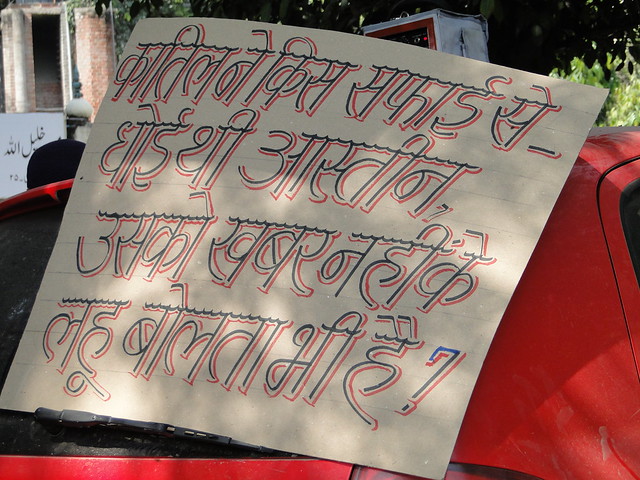
Although, as the honorable Judge in this case observed later, this particular case had nothing to do with their purported links with terror groups, and the fact is that the prosecution failed to produce any credible evidence to establish their basic premise that they were IM members hiding in that particular flat.
The then Lieutenant Governor of Delhi, NCT, Tejendra Khanna, opposed a Magisterial inquiry into this encounter, the Delhi minority commission’s four member fact finding committee was stopped from investigating the case. A confusion was created on the name of Shahzad (who was alleged to have shot dead inspector MC Sharma). Police initially mentioned him in different government documents as Shahnawaz or Shahabaz alias Pappu. Though police claimed to have seized his passport which will have his exact name but ironically they couldn’t find his exact name. A note prepared about the seizures by Karnal Singh (Joint-Commissioner of Police) and Satish Chandra’s letter (Special Commissioner of Police) did not mention the passport initially. These facts and many more speak twisted story of encounter. The death of MC Sharma also builds suspicion around the facts.
Politics however on the Batla Encounter has not stopped. There is an urgent need that politics over the death must stop. Unfortunately leaders of all colors have used the Batla House shootout for their own narrow political agendas. Several local politicians have literally risen over the dead bodies of those killed in that flat. Even national leaders have not shied away from exploiting the sentiments of people over the issue. I don’t need to name them again and again. All of us know how they attempted to manipulate emotions over the incident.
Both governments, at NCT Delhi and UPA at centre, have shown extremely callous attitude towards the demand for an independent probe. While they stress on the need to deal with the alienation of Muslim youth , the denial to order a magisterial inquiry into the encounter raises serious questions about government’s seriousness as a protector of rights and liberty.
Batla House Encounter has done irreparable damage to the psyche of the Muslims in country. Incidents like Batla House have created a sense of alienation and paranoia among Muslim youth.
The way enquiries were scuttled and facts were twisted, over and over again, speaks volume of the seriousness of the cases. It warrants an immediate judicial probe in the matter. The independent probe being asked by responsible leaders and general public is not only to punish the wrong-doers but also to bring back the common man’s faith in our democratic setup. But not only that, the probe can establish and closure to the soul of inspector MC Sharma and his family.
Questions galore on the death of MC Sharma
Even after eight years, details on how Inspector Mohan Chand Sharma was killed remains sketchy. Post-mortem report availed from NHRC through RTI does not reveal much, though it raises enough curious points towards the inconsistency in police version. In all such cases as per the NHRC guidelines videography of the post-mortem is carried out and the CD along with the pictures of the affected regions of the body of the victim is sent to the commission. It is not clear whether this was done in this case as only the photographs have been sent to the NHRC.
One of the interesting but untenable justification on why MC Sharma did not wear the bullet-proof jacket has been the ability of the jacket to attract public attention with a potential to disrupt the police plan of action (POA).
Another aspect that has been ignored in the analysis is the loss of around 2.5 to 3 litres of blood before Sharma died. This has not been explained whether this huge amount of blood was lost on the way from Batla House to Holy Family Hospital or during the time he was there till he was declared dead at 7.00pm local time. Photograph of Sharma being taken by his colleagues to the hospital does not show whether he was bleeding profusely. Sharma’s white shirt does not show any blood stains when he was on the street after being brought down from the fourth floor of L-18 where he was allegedly shot by Atif and Sajid.
We have attached the RTI response on whether the firearm wounds received by Inspector Mohan Chand Sharma can be caused by accidental firing of a colleague police officer of raiding party at the time of incident. (See: Image One).
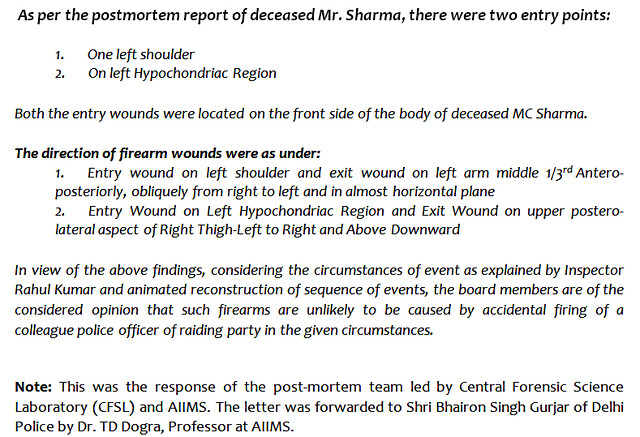
I also applied an RTI to Jai Praskh Narayan Apex Trauma Centre of AIIMS to access information on the postmortem reports of Atif, Saijd and MC Sharma. In the response to this RTI, AIIMS chose to invoke the Section 8 (g) and (h) of RTI Act 2005 to withheld information. Section 8 (g) refers to the information that can cause harm to someone’s life and 8 (h) refers to the information that can impede in the process of an ongoing investigation. Conveniently this was not explained how the postmortem reports of Atif, Sajid and MC Sharma could have harmed anyone else. Moreover, it was also not clear how the postmortem reports could have interfered in the process of police investigation.
Post mortem reports raise serious questions on authenticity of the encounter
From day one local community and activists had termed the Batla House encounter as fake. In the response to an RTI filed by me, the NHRC had provided the post mortem reports of Atif, Sajid and Inspector MC Sharma. These post mortem reports had created shockwaves around the country vindicating the claims of the parents of Atif and Sajid, the local community and the activists.
Meanwhile, the NHRC in its ‘enquiry’ extensively cited the postmortem report of Inspector Sharma to prove that he had been fired upon by alleged terrorists. The wounds suffered by the slain police officer were provided with great detail such as the places in the body where bullet injuries were found, their impact, ‘entry and exit points’ etc. Even the injury suffered in the arm by injured Constable Balwant Singh carried all this information but the same treatment is curiously absent in the case of Atif and Sajid, the slain ‘terrorists’. This is surely intriguing if you look at the images attached with this story (See Image Two).

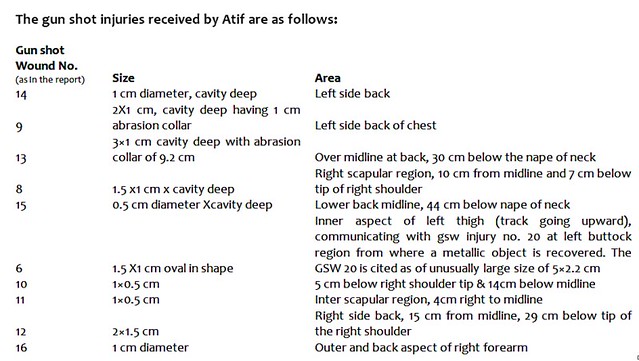
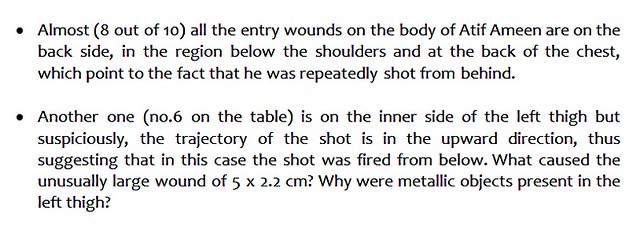
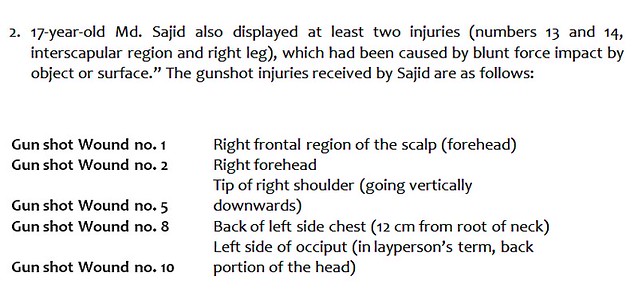
The entry points of each of these gunshot wounds—and the fact that all but one bullet is travelling in a downward direction—strongly suggests that he was held down by force (which also explain the injuries on the back and leg region), while bullets were pumped down his forehead, back and head.
In which genuine cross fire do people receive injuries only in the back and head region?
The all-important question is at why the NHRC deliberately ignored this incriminating and suggestive evidence? In its refusal to pursue any contrary line of investigation, it has proved itself to be in collusion with the Delhi Police, discarding even the minimum pretence of impartiality.
Why was no magisterial probe ordered in the encounter case?
A question on who is responsible for stalling the demand for a magisterial inquiry into the Batla House Encounter reveals interesting conjectures. Even before the High Court and Supreme Court passed orders in August and October 2009 respectively to reject the need for an independent probe, the Lt Governor of Delhi in January 2009 had cited the yet to come judicial orders to decline the requirement of a magisterial inquiry.
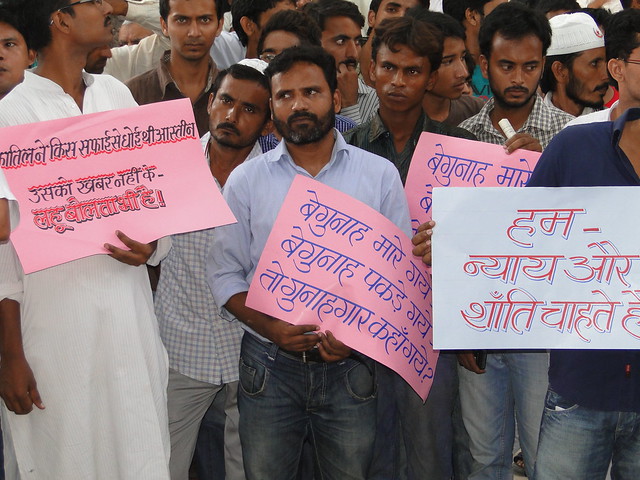
The last eight years have witnessed that the demand for an independent magisterial probe into the Batla House Encounter has been marred in departments passing the buck. The responses to the RTIs filed by me, reveal that the Lt. Governor of Delhi had rejected the need for an independent probe. This happened despite the fact that the National Human Rights Council (NHRC) has set guidelines since 2003 to conduct an independent magisterial inquiry in all police encounters.
NHRC had sent a series of notices from September to December 2008 to Delhi Police to submit a report on the encounter. An important notice was sent in January 2009 to Delhi Police to respond in six weeks time on the issues of magisterial inquiry. Delhi Police did not respond in the due time. NHRC in the meantime chose to publish a report on 20 July, 2009.
The NHRC response to an RTI confirmed that no magisterial inquiry could have been conducted as the Lt. Governor of Delhi did not favour such an inquiry. But the Lt. Governor’s response to our RTI on whether he had any communication with NHRC he replied in the negative. However, he agreed to have rejected the need of an independent magisterial probe.
The NHRC report released on 22 July 2009 citing a home ministry communication dated 21 January 2009 mentioned that the Lt Governor had declined to order a magisterial probe on or before. The curious aspect of this rejection as mentioned by the Lt Governor was influenced by the orders of the High Court and Supreme Court. He said that the High Court and Supreme Court did not feel the need for such a judicial probe and the Lt Governor cited this in his justification to reject the demand for an inquiry. It must be noted here that there was no such hearing of this case by January 2009. The High Court on 26 August 2009 on the basis of the NHRC report had rejected the plea for an independent probe and on re-appeals the Supreme Court on 30 October 2009 also has rejected the need for a judicial inquiry. By January 2009 when the case was not yet sent to the judiciary and the Lt Governor could sense the judiciary’s future possible orders!

